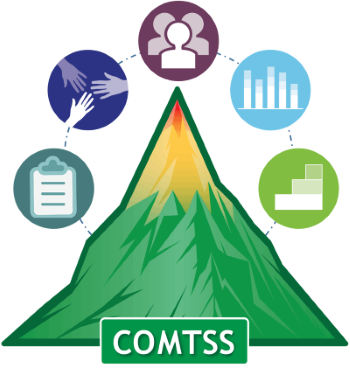CDE will be closed Wednesday, Nov. 27 through Friday, Nov. 29 for the Thanksgiving holiday.
You are here
Alignment with COMTSS
The How of Implementing the Landscape of Wellbeing and Belonging
As with academics, the features and elements of the Landscape of Wellbeing and Belonging are best implemented through Colorado's Multi-Tiered System of Supports (COMTSS), which provides a systematic framework for implementing prevention and intervention efforts that address school climate, student behavior, safety, mental health, student engagement, and more.
Colorado Multi-Tiered System of Supports (COMTSS)
COMTSS is a prevention-based framework using team-driven leadership and data-based problem-solving to improve the outcomes of every student through family, school, and community partnerships, comprehensive screening and assessment, and a layered continuum of supports. Implementation science and universal design for learning are employed to create one integrated system that focuses on increasing academic and behavioral outcomes to equitably support the varying needs of all students.
The Landscape is Supported Through the Five Components of COMTSS
For each of the five components of COMTSS (noted below), the Landscape provides you guidance and tools that help you and your team to prioritize the inclusion of wellbeing and belonging in your Multi-Tiered System of Supports (MTSS). Below the 5 components of COMTSS are expanded to include these concepts.
This ensures that teams consider the wellbeing and belonging of students, staff, and families when making decisions about prevention and intervention efforts.
This encourages schools to effectively partner with families and community organizations to improve the wellbeing and belonging of students and their caregivers to ensure positive educational outcomes.
This includes screening and assessing school climate, discipline practices, and social, emotional, physical and mental health.
This requires the inclusion of non-assessment data such as perception surveys, universal screenings, discipline, chronic absenteeism, etc. to be considered when using data to make decisions.
This defines the supports that should be implemented at Tier 1, Tier 2, and Tier 3 to improve wellbeing and belonging, with an emphasis on prevention in the universal tier, followed by coordinated student-centered supports in Tier 2 and 3.
An Integrated Approach to COMTSS and the Landscape
Tier 1 in the Landscape
Tier 1 Supports are provided to ALL students, independent of mental and behavioral health challenges or risk, and may be provided at the classroom, grade, or school level. They are designed to provide the foundation for Tier 2 and 3 Interventions.
Examples of Tier 1 Supports include:
- Equity, Inclusion, and Culturally Responsive Practices
- Positive Behavioral Interventions and Supports
- Mental Health Literacy
- Suicide Prevention
- Bullying Prevention
- Schoolwide Social and Emotional Learning
- Universal Breakfast and Lunch
- Positive Interactions for Every Student Every Day
- Relationship-Centered Discipline
- Trauma-Responsive Practices
- Safety - Physical, Psychological, Identity & Academic
- Out of School Time Opportunities
- Comprehensive Health and Physical Health Education
- Opportunities for Physical Activity Throughout the School Day
- Experiential and Service-Learning Opportunities
Tier 2 in the Landscape
Tier 2 supports are provided to some students based on identified needs that are not addressed through universal/Tier 1 programming. Tier 2 supports are not just provided by special service providers (i.e., school psychologists, etc.), but rely on coordination and support from all adults who interact with students identified for Tier 2 supports.
Examples of Tier 2 Supports include:
- Safe Spaces for Emotional Regulation
- Small Group Social Skills Instruction
- Behavior Corrections and Redirects
- Bullying Interventions
- Check-In Check-Out
- Restorative Practices
- Mentoring
- In-School Interest Clubs
- Social Identity-Affirming Groups
Tier 3 in the Landscape
Tier 3 supports are intensive and individualized supports provided to a few students experiencing significant distress or mental/behavioral challenges that are not addressed with Tier 1 or Tier 2 supports.
Examples of Tier 3 Supports include:
- 1:1 Mentoring
- Referral to Treatment
- Re-entry and monitoring
- Individual Counseling
- Behavior Intervention Plans
- Threat Assessment
- Wrap-around services









Connect With Us




